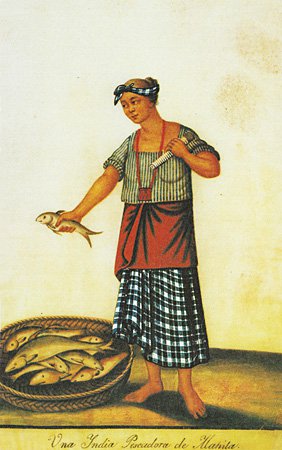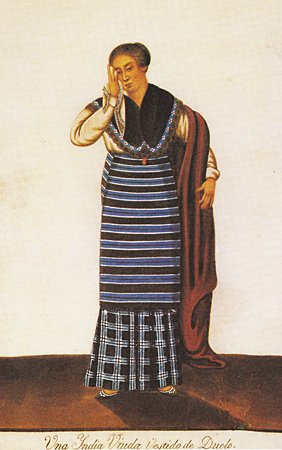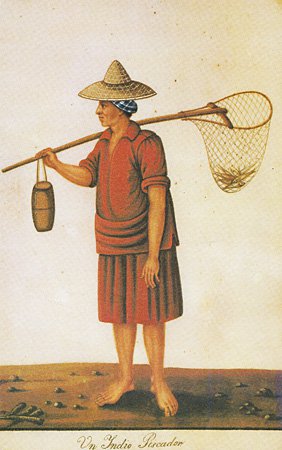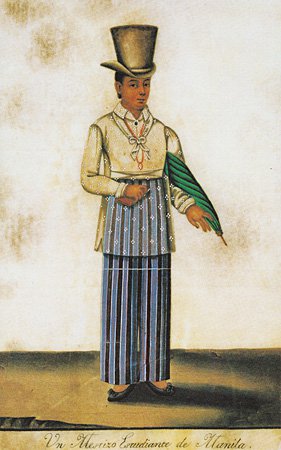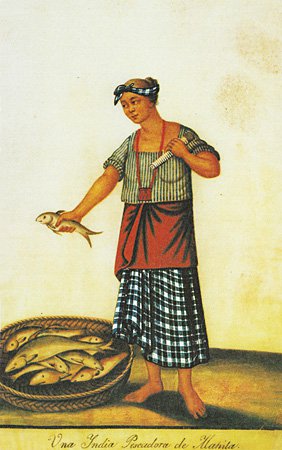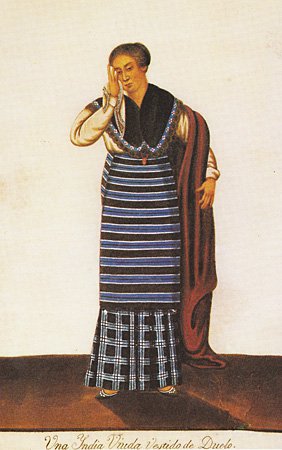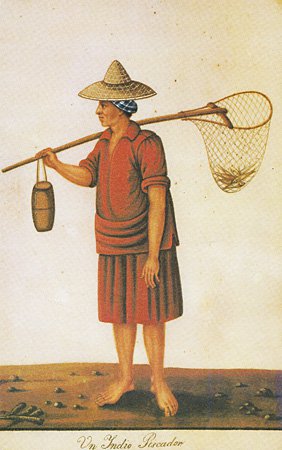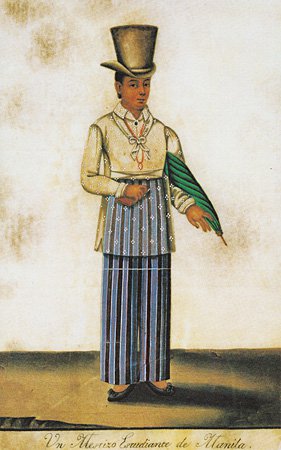Cultural Center of the Philippines
ENCYCLOPEDIA OF
PHILIPPINE ART
Coleccion de Trajes de Manila y de las Provincias
(Collection of Costumes of Manila and the Provinces) / Circa 1830 / Waterbased tempera on pith paper / Each plate approximately 15 x 11 centimetres / Artist: Damian Domingo / Paulino and Hetty Que Collection
The albums of costumes were compiled during the first quarter of the 19th century, primarily to advertise the different products and industries of the different inhabitants of the Philippines. The demand arose after the liberalization of trade policies with non-Spanish Europeans, including the British, who were previously banned from trading in Manila. So far six albums are known to exist, including one formerly in the National Library, amply documented but destroyed during World War II. Of the five extant, four have title pages—namely, those in the Newberry Library (Chicago), the Ayala Museum, the collections of Paulino and Hetty Que and Dr Eleuterio M. Pascual. The Que folio is contained in two albums with a dedication each to Grace and Eliza Douglas, signed “from her affectionate Papa, January 1833.” The Pascual album was discovered in the estate of the 13th Earl of Derby and bears the crest of the peer. The number of plates differs per album. The Newberry has 29 plates of Filipino costumes; the Ayala Museum has 28 of Filipino costumes; the Que album has 29 plates of Filipino costumes; the Pascual album originally contained 17 Filipino costumes (two are now in a different collection) and eight Chinese costumes. All the albums were commissioned and collected by Rafael Daniel Baboom (d. 1832), a Madras entrepreneur who in turn sold them to British textile traders.
The Que album is outstanding not just for having 29 plates all inscribed with a caption in Spanish. The titles suggest the social class, region, and racial breed of the subjects. The English translations of the inscriptions in the plates in the Que album are as follows: (1) An Indio Municipal Captain, (2) An Indian Woman of Manila in Gala Array, (3) A Clerk of the Governor of Manila, (4) An Indian Lady Going to Mass with a Young Girl, (5) An Indian Field Worker, (6) An Indian Native from Pampanga with His Pipe, (7) An Indian Native from the Province of Pangasinan, (8) An Indian Boatman from Manila, (9) An Indian Woman from the Visayas, (10) An Indian from Manila Dressed in Gala Attire, (11) A Half-Breed Girl from Manila in Gala Attire, (12) An Indian Woman from Ilocos, (13) A Mestizo Student from Manila, (14) An Indian Fish Vendor from Manila, (15) A Spanish Mestiza Dressed in Gala Attire, (16) An Indio Bailiff from the Town of Tondo, (17) A Mestiza Shopkeeper from Manila, (18) A Commissioned Soldier, (19) An Indian Laundrywoman from Pangasinan, (20) An Indian Stevedore, (21) An Indian Fisherman, (22) A Mestizo Cleric from the Town of Santa Cruz, (23) An Indian Woman Dressed in Mourning, (24) An Indian Cart Driver in Manila, (25) An Indian Pot Vendor of Pasig, (26) An Indian Boatman from the Town of Pasig, (27) A Mestiza from Pampanga, (28) An Indian Inhabitant from the Province of llocos, and (29) An Indian Native of Visayas.
Each plate shows a highly detailed drawing of a costume. The bright hues employed to capture the actual colors of the dress appear flat. Domingo, however, used tonal modulations to suggest the volume of faces and hands. The embroideries stand out in the color areas, being rendered in white. The exquisite skill bears out Domingo’s metier as miniature portraitist. Since the plates contain many circumstantial details, they serve as an important documentation of the social, cultural, and economic life in the first three decades of the 19th century.
Written by Santiago A. Pilar (1994)
